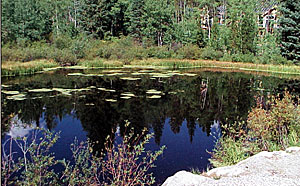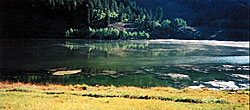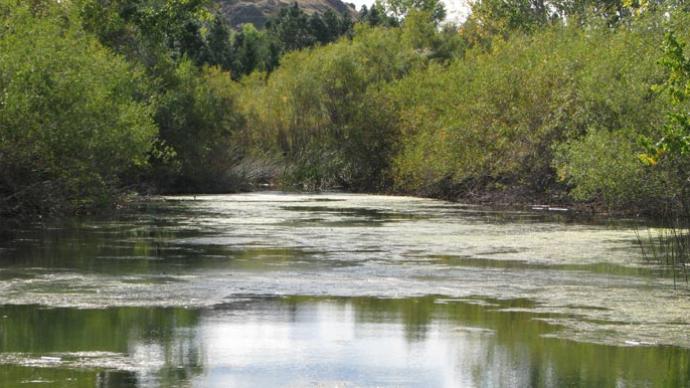
No, these are not descriptions of every football team that kicked the pants off of my son's team last season. They are common descriptions used by our clients to describe algal infestations in their ponds. You have probably thought similar thoughts and worse (@X**!) when this simple life form invades water space on your property. I would like to take you on a two article journey to aid understanding about what freshwater algae is, what it's good for, how it behaves, and how to deal with it before it gets out of control.
Professional pond Docs like myself receive anxious landowner telephone calls on algae infestations more than any other single problem. Algae are a simple organism evolved early in the development of life on this big blue and green rock we call home. Alga taxonomy, however, is quite a complex topic with some species behaving like neither plants nor animals. Biologists opinions differ but generally recognize 10 different phyla (major divisions of the organisms known as freshwater algae) containing many hundreds of species. Because of its simple needs; moisture, sunlight, nutrients, and the right temperature, algae have developed into a diverse group of organisms. The point here is many forms of algae can invade your water space. When you diligently try to control one infestation, BAM!!--a few days later, the bloom is back. More than one pond manager cusses their failure without realizing another species has taken hold and it’s time to start all over again. This misunderstanding is why chemical control of algae can be an expensive undertaking, even in a small pond.
Algae are the foundation of the aquatic food web and are valuable in the right proportion. Every species of fish in your pond, especially forage fish, utilize algae at some point in their lives. Algae are 'primary producers' meaning it can turn solar energy into plant biomass, thereby introducing valuable energy to the pond system. The conversion of solar energy to biologically usable plant protein is extremely valuable and, in my mind, a gift. Understanding what makes algae tick is important. Assuming habitat conditions are right, (water temperature, day length, sunlight penetration, area of water), the single driving force for most algae proliferation is nutrients. Classic lake studies identified many decades ago the single limiting factor to production in standing water is phosphorous. Dissolved phosphorous exists in most freshwater in minute amounts. It, therefore, can be depleted quickly by plant growth and must be replenished by in-lake sources. As water temperature increases, so does plant activity (photosynthesis) and therefore greater amounts of phosphorous are utilized. Most ponds replenish phosphorous from the sediments. As pH and dissolved oxygen decrease, more phosphorous is released from sediments.
To enhance nutrients, many pondmeisters employ pond fertilization. Fertilization creates conditions which allow algae to grow and start fueling the food web. Fertilizers employed contain both phosphorus and nitrogen as nutrients. More recent studies have identified a relationship between algae production and phosphorous. Under ideal conditions, for each single gram of phosphorous introduced to the pond, 1000 grams of algae (wet weight) can be produced. This relationship helps explain the rapid infestations algae can heap on our favorite pond. It is no coincidence most rapid infestations I have observed occur in ponds close to human activity. Nutrient control must be included in every algae control plan, but we will discuss that in the next Pond Boss.

Algae identification is important if you plan to manipulate it (fertilize or control). Algae identification is difficult to the species level and is not necessary to achieve reasonable success. A good source for algae identification is your local extension service or regional state fish biologist. A regional network of experts is often in place for such esoteric undertakings. I have spoken with many extension agents and other biologists over the years to aid in aquatic plant identification. If you plan to take a sample to them place it in a wet paper towel and keep it cool. Get it to them as soon as possible to avoid putrefaction from decomposition.
In the Rocky Mountains, we deal with a number of groups of algae including green (Chlorophyta), blue green (Cyanophyta), brown (Phaeophyta), and red (Rhodophyta) algae. Like other areas of the country, green and blue green algae are the most commonly distributed types. Green algae takes on three structural forms; planktonic, filamentous, and attached. Most other algae, including blue greens, are limited to planktonic/colonial forms manifesting themselves in blooms that suspend in water or coat substrates like rip rap.
Temperature is a significant determinant of type and species of algae. Temperature and nutrient availability often determine our seasonal succession in Rocky Mountain ponds. Species of coldwater filamentous algae begin to grow early in the year under ice attached to bottom substrates. Species requiring warmer water proliferate through spring and summer in surface waters (planktonic, attached and filamentous). Coldwater species return in the fall, often as short lived plankton blooms, as ice forms on ponds. Planktonic algae are microscopic single and multi-celled linkages that turn water green or blue green. Colonies of certain algae can be seen in windrows along the shoreline. Algae "blooms" are not as important to the seasonal food chain in coldwater ponds as vascular plants so we do not fertilize in the high country. Blooms are more of a threat to pond health due to the dramatic daily shifts in pH that high photosynthetic activity causes. Heavy blooms also represent high potential for oxygen depletions when lack of sunlight or late summer cold fronts cause algal mortalities. Occurrence of blue green algae blooms in high elevation lakes indicates, to our educated eye, a pond saturated with nutrients, often due to old age or pollution. We also have a few species of blue green algae that produce toxins and can cause mortality in higher animals, such as livestock.
Filamentous algae are responsible for eliciting more expletives in the Rocky Mountain region than any other simple form. My experience in other areas of the country over the decades indicate it has few fans anywhere. Green filamentous algae, colloquially and inaccurately referred to as "moss," is long-stranded algae resembling wet cotton often located in shallow water. This algae generally proliferates in high nutrient areas (near drainage inlets, on the surface of sediments, or on top of existing vegetation stands) reaching maturity within days of initiating. As algae grows, gases (especially oxygen) become entangled in vegetation strands helping buoy algae to the surface. This adaptive mechanism helps filamentous algae to stay in abundant sunlight where life is good. When filamentous algae forms floating mats it causes serious conflicts for many pond owners, not the least of which are aesthetic in nature. When overabundant, it represents a serious threat to the health of the pond due to potential oxygen depletions when it dies off.
The prince of algae in the Rocky Mountain Region, and in any area where conditions are right, are the attached structural forms known as Stoneworts. The name Stonewort comes from plants ability to cause changes to water quality in the microzone next to the plant causing dissolved solids, such as calcium carbonate, to precipitate onto the plant giving it a hard coating. In our area, muskgrasses (Chara spp.) are the most common group observed. This green to lime green plant is attached to the bottom, growing in areas of low physical disturbance. Muskgrass is rarely found to grow to the surface. Its multi-stemmed and branched appearance causes it to look similar to other non-algae pond plants. Chara is easy to identify by picking a small amount and observing its hollow stems and strong musky odor. This slow growing algae has well known associations with the group of coldwater critters referred to as "freshwater shrimp." In the mountainous region, there are areas containing cold, hard water lakes where muskgrass is the dominant vegetation. The area around Laramie, Wyoming has such lakes resplendent with Chara and freshwater shrimp that grow trout at the phenomenal rate of 2 inches per month. Trout in these lakes commonly reach sizes of 6-8 lbs in 5 years (generally the end of their lifespan). These trout attract anglers even in the dead of the cold Wyoming winter when a 40 mile per hour wind blows constantly. These ruby-meated delicacies get me out of winter hibernation often, but unfortunately my ice shanty was last seen riding the jet stream just east of Chicago!
I have referred to algae as simple plants-and to plant ecologists they may be. We, as lovers of the water world, know that algae are anything but simple to deal with. The next time you are near your pond fertilizing the landscape take care that you do not inadvertently add fuel for your next algae problem. Remember, your pond is a nutrient sink meaning that once a nutrient is introduced; there are a number of natural cycles that make sure nutrients remain in the system. In the next article I'll discuss approaches to minimizing and controlling algae in your pond. Controlling algae in my experience has been far more surmountable than some of the football teams I spoke of earlier. Considering this year’s football record for the Longmont YMCA Dragons, we have decided that it's a good thing that swimming lessons start soon.
Mike Mitchell is Senior Aquatic Biologist for Queen of the River Fisheries, based in Longmont, Colorado.
Reprinted with permission from Pond Boss Magazine



